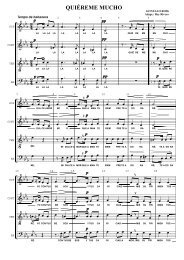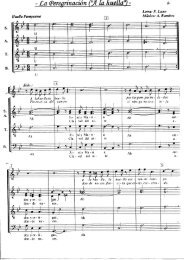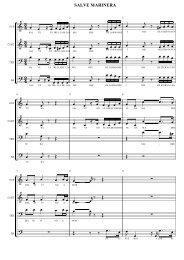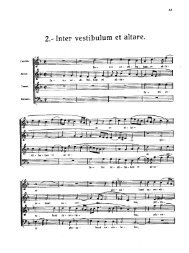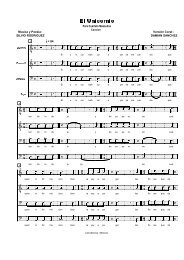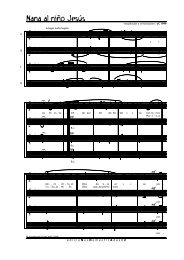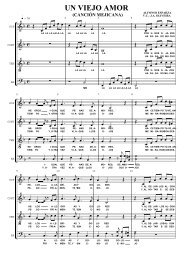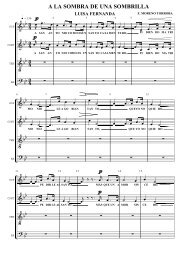REINA DE TODO ARAGÓN Cunchillos - PARTITURAS de MúSICA ...
REINA DE TODO ARAGÓN Cunchillos - PARTITURAS de MúSICA ...
REINA DE TODO ARAGÓN Cunchillos - PARTITURAS de MúSICA ...
Create successful ePaper yourself
Turn your PDF publications into a flip-book with our unique Google optimized e-Paper software.
2268 LEBE<strong>DE</strong>VA, KESLER, AND CARTERlyzer in the tension mo<strong>de</strong> at a heating rate of10 °C/min (10 Hz). The <strong>de</strong>nsity measurementswere obtained with a <strong>de</strong>nsity gradient columncomposed of water and calcium nitrate. The columnwas calibrated against a set of beads ofknown <strong>de</strong>nsities (Scientific Glass & Instruments,Inc.) and maintained at 25 °C (<strong>de</strong>nsity 1.07–1.45). At least two specimens were used for each<strong>de</strong>nsity measurement. Macromonomer end-grouptitrations were performed with a Metrohm 736GP Titrino unit with a standardized tetrabutylammoniumhydroxi<strong>de</strong> solution in methanol,and averages were taken of five duplicate measurements.Monomer and Polymer PreparationCatalyst Solution Preparation: 5,10,15,20-Tetraphenylporfinato Aluminum Chlori<strong>de</strong> (1)In a drybox, a 500-mL, round-bottom flask wascharged with tetraphenyl porphyrin (4.72 g,7.67 mmol, 1 equiv) dissolved in 200 mL of methylenechlori<strong>de</strong>. Diethylaluminum chlori<strong>de</strong> (9.2 mL,9.2 mmol, 1.2 equiv) was ad<strong>de</strong>d slowly with stirring.After the addition was complete, the catalyst solutionwas left to stir for 4 h before use.Preparation of Hydroxy-Terminated Poly(propyleneoxi<strong>de</strong>) Oligomer (PPO-OH or 2)A solution of freshly prepared catalyst (1) wascooled to 0 °C, and freshly distilled propyleneoxi<strong>de</strong> (23 g, 396 mmol, 52 equiv) was ad<strong>de</strong>d via aneedle. The reaction was left to stir overnightun<strong>de</strong>r a nitrogen flow at room temperature. Afterthe workup, the mixture was shaken well withconcentrated HCl (3 mL) and CH 3 OH (10 mL),and methylene chlori<strong>de</strong> was removed in vacuo.The semisolid, purple residue was dissolved indiethyl ether and filtered through Celite. The filtratewas washed with 20 mL of concentratedHCl, and the ether layer was filtered throughCelite to remove the residual insoluble catalyst.The solution was then further subjected to a waterwash, a base wash (a solution of 10 mL of 50%NaOH in 300 mL of water), a sodium bicarbonatewash (10% NaHCO 3 ), and a water wash again.After each washing step, the ether layer was filteredthrough Celite. The resulting light pinkether solution was stirred for 12 h over charcoaland anhydrous MgSO 4 . Filtration through Celiteand concentration in vacuo affor<strong>de</strong>d PPO as alight yellow, viscous liquid. Traces of water inPPO were removed as an azeotropic mixture (water/toluene)by distillation with toluene. Dry andpure monohydroxy-terminated PPO (14.2 g) wascollected (66%). The oligomer had a molecularweight of 2700 g/mol, as <strong>de</strong>termined by GPC.1 H NMR (acetone-d 6 , ): 1.10 (d, 3H, CH 3 ), 3.31(m, 1H, CH), 3.40 (d, 2H, CH 2 ).Preparation of Macromonomer Precursor Benzene1,2,4,5-Tetracarboxylic Acid 2,4-Bis[poly(propylene oxi<strong>de</strong>)] Ester (3)2 (8.32 g, 3.2 mmol, 2 equiv) was dissolved inethyl acetate (100 mL), and PMDA (0.35 g,1.6 mmol, 1 equiv) was ad<strong>de</strong>d. The reaction wasallowed to reflux for 48 h. The product was transferredto a clean flask and concentrated in vacuo;this yiel<strong>de</strong>d 8.3 g of 3 as a very viscous, yellowfluid. NMR analysis revealed that the reactionwas nearly quantitative, and it was used in thenext step with no further purification.1 H NMR (acetone-d 6 , ): 1.11 (d, 264H, CH3),3.38 (m, 88H, CH), 3.54 (m, 176H, CH2), 8.31 (s,1H, aromatic H), 8.39 (s, 1H, aromatic H), 12.1 (s,2H, COOH).Preparation of Macromonomer 4,6-Bischlorocarbonyl Isophthalic AcidBis[poly(propylene oxi<strong>de</strong>)] Ester (4)Macromonomer 3 (10 g, 1.6 mmol, 1 equiv) washeated in ethyl acetate to 55 °C and slowlytreated (dropwise) with oxalyl chlori<strong>de</strong> (4 g,32 mmol, 20 equiv). The materials were allowedto react at 55 °C for 24 h, and the mixture turnedbrown-red. The ethyl acetate and excess oxalylchlori<strong>de</strong> were removed in vacuo, and several subsequentethyl acetate additions and distillationswere performed to ensure complete oxalyl chlori<strong>de</strong>removal. Finally, the product (4) was concentratedin vacuo as a viscous, brown liquid with anisolated yield of 10.2 g (100%). The molecularweight of macromonomer 4 was 6380 g/mol, as<strong>de</strong>termined by titration with terabutylammoniumhydroxi<strong>de</strong>.1 H NMR (acetone-d 6 , ): 1.1 (d, 282 H, CH 3 ),3.38 (m, 94H, CH), 3.47 (m, 188H, CH 2 ), 8.54 (s,1H, aromatic H), 8.57 (s, 1h, aromatic H).10% PPO-co-PAE Graft Copolymer(Typical Procedure)All reaction setups and the addition of thereagents and reaction vials were performed in anitrogen-atmosphere drybox. In a 15-mL vial,macromonomer 4 (0.3500 g, 0.0612 mmol) was
SOPCONTTENBASOPCONTTENBA55 HUESCA O<strong>DE</strong> TE HUESCA O <strong>DE</strong> GO60HUESCA O<strong>DE</strong>TESER A RA GOSER A RA GOTE SER A RA GO SER A RA GO615657 SI <strong>DE</strong> SI <strong>DE</strong> SI <strong>DE</strong> RUEL,RUEL,RUEL,NENE SANE SANE SAHA <strong>DE</strong>HA <strong>DE</strong>HA <strong>DE</strong>NE SA HA <strong>DE</strong>62SE AS MU JERSE AS MU JERSE AS MU JERSA HASER.SER.SER.SER. YA LO VE USYA LO VE USYA LO VE USYA LO VE US6358BE LLA A RABE LLA A RA BE LLA A RA<strong>DE</strong>TED.rit.rit.¡VITED. ¡VIrit.TED.TED.rit.¡VI¡VI64VA AVA AVA AVA A59GOGOGOSERRARARARA NE SA HA <strong>DE</strong> NE SA HA <strong>DE</strong> NE SA HA<strong>DE</strong>65GÓN!GÓN!GÓN!GÓN!<strong>REINA</strong> <strong>DE</strong> <strong>TODO</strong> <strong>ARAGÓN</strong> 4




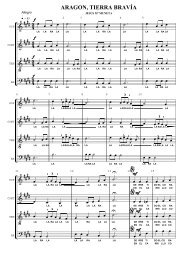
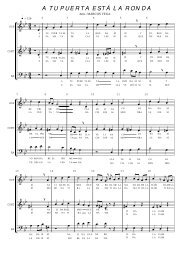
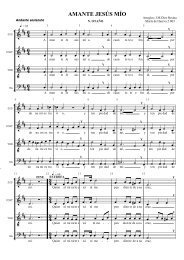
![Finale 2006 - [Kaming Magmamani]](https://img.yumpu.com/50854913/1/184x260/finale-2006-kaming-magmamani.jpg?quality=85)
